
In the diagram shown above and are refractive indices of the media 1, 2 and 3 respectively. Which one of the following is true in this case ?
Step by step video & image solution for In the diagram shown above n_(1), n_(2) and n_(3) are refractive indices of the media 1, 2 and 3 respectively. Which one of the following is true in this case ? by Physics experts to help you in doubts & scoring excellent marks in Class 10 exams.
Updated on:21/07/2023Topper's Solved these Questions
- QUESTION PAPER 2022 TERM1BOOK - X BOARDSCHAPTER - QUESTION PAPER 2022 TERM1EXERCISE - Section -C
4 Videos
- QUESTION PAPER 2022 TERM1BOOK - X BOARDSCHAPTER - QUESTION PAPER 2022 TERM1EXERCISE - Section -A
4 Videos
- QUESTION PAPER 2022 TERM 2 SET 3BOOK - X BOARDSCHAPTER - QUESTION PAPER 2022 TERM 2 SET 3EXERCISE - SECTION C
4 Videos
- QUESTION PAPER 2023BOOK - X BOARDSCHAPTER - QUESTION PAPER 2023EXERCISE - Question
16 Videos
Similar Questions
A,B, and C are the parallel sided transparent media of refractive indices n1,n2 and n3 respectively. They are arranged as shown in the figure. A ray is incident at an angle i on the surface of separation of A and B which is as shown in the figure. After the refraction into the medium B the ray grazes the surfaces of separation of the media B and C. then sini equal to

View SolutionA ring angled isosceles prism KLM of refractive index n1 is placed inside a rectangular block PQRS of refractive index n2 as shown in the adjoining Fig. The rectangular box is surrounded by a medium of refractive index n3. A ray of light AB enters the rectangular block normally. Depending upon the relationships between n1,n2andn3. it takes one of the four possible paths.

Under what condition the ray follows the path no. 1 (i.e., path ABCI)?
View Solution
Knowledge Check
Consider the formal charges on N and B in H3N−BF3 and indicate which of the following is true?
AN is +ve and B is -veBN is -ve and B is +veCboth N and B carry similar +ve or- ve chargesDCharge discrimination is difficult to makeConsider the formal charges on N and B in H3N−BF3 and indicate which of the following is true?
AN is +ve and B is -veBN is -ve and B is +veCboth N and B carry similar +ve or- ve chargesDCharge discrimination is difficult to makeThe refractive indices of two media, are denoted by n1 and
n2 and the velocities of light in these two media are
respectively v1andv2.Ifn2/n1 is 1.5, which one of the following statements is correct?Aa v1 is 1.5 times v2Bbv2 is 1.5 times v−(1)Cc v1 is equal to v2.Dd v1 is 3 times v2.
A biconvex lens made of material with refractive index n2. The radii of curvatures of its left surface and right surface are R1 and R2. The media on its left and right have refreactive indices n1 and n3 respectively. The first and second focal lengths of the lens are respectively f1 and f2.
Assume that n1=n3. Which of the following statements is not correct ?
View SolutionA biconvex lens made of material with refractive index n2. The radii of curvatures of its left surface and right surface are R1 and R2. The media on its left and right have refreactive indices n1 and n3 respectively. The first and second focal lengths of the lens are respectively f1 and f2.
Assume that R1=R2,n1≠n3. The ratio, f1/f2, of the two focal lengths is equal to
View SolutionA biconvex lens made of material with refractive index n2. The radii of curvatures of its left surface and right surface are R1 and R2. The media on its left and right have refreactive indices n1 and n3 respectively. The first and second focal lengths of the lens are respectively f1 and f2.
The ratio, f1/f2, of the two focal lengths is equal to
View SolutionSix benches N1, N2, N3, N4, N5 and N6 are kept one above the other (not necessarily in the same order). N4 is above N3 and N5 only. There are four benches between N1 and N5. N2 is three places above N3. Which of the following statements is not correct?
View SolutionIn an optical fibre ,the refractive indices of the core and the cladding are given by n1 and n2 respectively . Light can travel through the optical fibre if
View Solution
